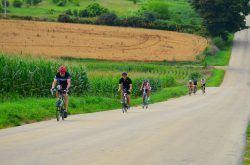The lure of a century or 100-mile ride captures the heart of many cyclists. The first one you complete is always a special achievement, and thereafter the goal is often to finish faster and faster. We all know that the fitness progression is not a continually upward trend. It comes with spurts of improvement and plateaus of performance that can become demoralizing. While it’s nice to see the fitness increasing, you don’t always have to look at your fitness level as the sole indicator of performance. Here are some tips to help you shave time off your century without changing your fitness level.
Finding a good group is the fastest way to a quicker finish because it instantly makes the ride 30% easier. However, finding the right group can be a challenge. Even moving fast, a century is a long ride. So you want to be careful not to overextend yourself in the first hour only to find yourself depleted in the last 20 miles. The ideal group should move at a pace close to your fitness level, ride predictably and keep the pace very steady. Faster and more chaotic groups not only waste energy, they create nervous riders and this can tire you out even if you’re not physically fatigued.
Depending on your fitness and the terrain of your event, you’re likely to find yourself riding on your own at times. Knowing your sustainable pace or effort for both flats and climbs will let you use your energy wisely so you’re fresh enough to make it to the finish and have a little bit of extra punch to jump in with another group that may come from behind. It is also important to be mindful of your effort when you’re in the group. If they’re hitting climbs hard and putting you into the red zone, it is likely better to find a more sustainable pace for yourself or try to organize others in a similar situation. However, if the pace is just slightly uncomfortable or it is later in the event, sticking it out will likely pay off because you’ll still be there to take advantage of the draft when the pace eases off.
Know your enemy, which in this case is the route. Covering 100 miles can involve many different elements: terrain changes, temperature swings, variable pavement, wind shifts. If it is an event you’ve done before, try to look back over your notes (in the training log you’ve been dutifully keeping!) from previous rides to refresh your memory. If it is close to home, complete some of your training rides on the course, especially in the final month leading up to the event. If pre-riding the course isn’t an option, try to locate online reports from others who have ridden the event and complete your training in conditions and terrain that mimic those expected at the event as closely as possible.
Knowing the course becomes a huge advantage in learning to shift efficiently and knowing what gears you’ll need on different parts of the course. Get in the habit of shifting to appropriate gears at the bottom of a climb before it gets really steep. Often riders spend a lot of time riding in the large chainring and when they hit a climb, they shift easier and easier until they are out of gears. Since they are starting to bog down, they drop to the small chainring, and if they avoid dropping the chain completely, they still face a near standstill condition for a split second due to the sudden change in chain pressure and pedal torque. Cadence should remain relatively constant around 85-90 rpms under most conditions. You will be equally inefficient grinding away at 50 rpms and spinning at 100 rpms but using a gear so small you can’t make any headway.
Finally, learn what your body needs in terms of food and fluids to meet the demands of a century and practice this strategy in training. Taking in 300-400 calories per hour and one full water bottle is a good starting point. Many riders have their favorite products, but it’s helpful to know what will be available at the aid stations on the course as well. Speaking of aid stations, another obvious way to improve your finish time is to spend less time stopped. Aid stations are often clustered close together to accommodate a range of fitness levels. Skipping the first one, or sometimes two feed stops, can help you to avoid heavier traffic and allow you to get in and out more quickly at later stops. It’s easy to carry enough supplies on your bike and in your pockets to make it 35-45 miles—a distance which should allow the field to thin out a bit. If you’re riding with a group, getting in and out of stops quickly can be a challenge. To help prevent this, everyone should keep one rule in mind: always be doing something! Know what needs to be done and check these things off your mental list: fill bottles (check), restock pockets (check), bathroom break (check), rolling down the road again (check).
Incorporating these strategies into your century plan will help you to find additional time on the course by using your energy more wisely. Of course, this is no excuse not to train! If you continue training consistently, you will improve your fitness even more and, coupled with these strategies, see an even bigger jump than you expected.

